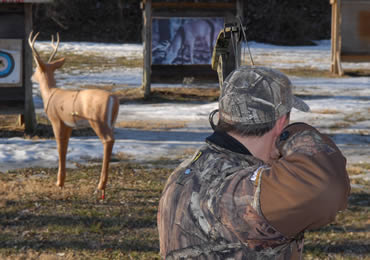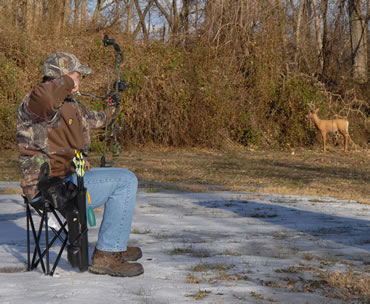By P.J. Reilly
Five Tips that will make you a better shot with a bow.
The closer the buck inched toward my treestand, the louder my heart pounded in my ears. It was Nov. 1, 2010, and a fine Pennsylvania 9-pointer had found the spot where I’d started the doe-in-estrus scent trail that ended at the base of my tree.
My trail was reeling the buck in, but his progress was agonizingly slow. The buck was approaching from my back, where I had no shooting lanes through which to sneak an arrow. I’d have no shot until he passed my tree. When he was 10 yards out, my whole body shivered, but I wasn’t cold. Sweat trickled down my temples.
The buck stood directly beneath the platform of my stand when I realized I’d made a tactical error by not extending the scent trail another 15 yards. Since the trail ended at my tree, the buck made one circle around the base and then picked up his head as if to say, “Where’d that doe go?”
That’s when he apparently heard my shuffling feet and ripped his head sideways to look up. The instant he saw me, he bolted.
Then, something magical happened.
I should have been freaking out that I’d possibly blown a golden opportunity at a fine trophy. Instead, electric charges started firing inside my cerebellum, and my body transformed from a quivering mess to a well oiled machine. I drew my bow as the buck hopped away. Something told me he’d stop within bow range and that I needed to be ready when he did.
Twenty-five yards from my stand, the buck halted and turned broadside. Instinctively, I knew the steep downward angle meant I should use my 20-yard pin, which locked on the crease behind the buck’s shoulder the instant he froze. A nanosecond later, I touched the trigger on my release.
I don’t think the buck had yet identified the threat he was running from when the arrow hit him square in the vitals. Thirty minutes later, I lifted his dark rack out of the leaves.
The things I did right on that hunt had little to do with conscious thought and a lot to do with muscle memory honed in the off season.
“Shooting at a deer is a pretty nerve-wracking experience no matter how many times you do it,” said Mathews prostaff shooter Levi Morgan. “That’s why we all love it so much. It helps calm things down if your body knows ahead of time what to do to produce a good shot. That’s what muscle memory is all about.”
BLIND-BALING
Before he became a professional archer, Morgan often went blind-baling in the time between hunting seasons. Blind-baling is shooting at a target with no focal point on it. As a year-round tournament competitor these days, Morgan said he shoots into an empty bale whenever he’s worried about target panic, regardless of the time of year.
“Your whole focus is on your shooting form and not on where you hit the target,” he said. “It’s great practice.”
Good shooting form is the most basic component of a good archery shot. And yet, it’s something few bowhunters work on in the off season, said shooting instructor Rob Kaufhold, owner of Lancaster Archery Supply in Pennsylvania.
Shooting at an empty bale lets the archer think about keeping his or her feet shoulder-width apart, relaxed hand placement on the bow handle, drawing smoothly, finding the same anchor point time after time and, finally, achieving a clean, twitch-free release.
 “It’s human nature to want to control everything, and if you only shoot at targets, you’re going to want to control the sight pin, which is impossible,” Kaufhold said. “That pin dances for everybody. But if you have good shooting form, when it comes time to shoot at a target, you’re going to feel confident that you’ll be able to release when your pin dances naturally across the bull’s-eye.”
“It’s human nature to want to control everything, and if you only shoot at targets, you’re going to want to control the sight pin, which is impossible,” Kaufhold said. “That pin dances for everybody. But if you have good shooting form, when it comes time to shoot at a target, you’re going to feel confident that you’ll be able to release when your pin dances naturally across the bull’s-eye.”
Often when he’s blind-baling, Morgan will move to within 4 or 5 feet of the backstop so there’s no way he can miss it, and he’ll close his eyes after he comes to full draw.
“That way, when I release, I’m not looking at anything,” he said. “All I’m thinking about is the release and what a good shot feels like.”
AIM, BUT DON’T SHOOT
This drill is the companion to blind-baling. With a target fixed to a backstop, draw your bow and aim, but don’t shoot.
“All you want to do is get a feel for how the pin floats on a target,” Kaufhold said. “You’re not going to try to force the pin to do something because you’re not focusing on the end result of hitting the target.”
As you might expect, the more you practice aiming, the more your pin will settle down. It’s true every shooter’s pin dances a bit, but it dances less for some than others.
“What I like about this is you can practice it anywhere because you don’t have to have an arrow on the bow,” Kaufhold said. “You can practice aiming in your living room and use anything as your bull’s-eye. Just make sure you don’t dry-fire your bow.”
As the pin slides across your aiming point, you can visualize the release you’d need to make for the arrow to find its mark.
BACK UP
Kaufhold has seen plenty of bowhunters who torque their bows just a tad the instant they release an arrow. Shooting at a target 20 yards away with a bow that slings arrows more than 300 feet per second, that little twitch isn’t always detectable.
“Back up to 50 yards, and every mistake is magnified,” Kaufhold said. “If you’re used to shooting at 20 and 30 yards, back up to 50 or 60 in the off season. You’ll find out real quick if you’re doing something wrong.”
The math is simple. Pull an arrow 1 inch to the left at 20 yards, and that inch can grow to feet as the shot gets longer.
“Long-distance shooting really helps tighten your form,” Morgan said. “You can get away with bad habits at 20 yards, but to consistently hit the bull at 60 yards, you have to be pretty tight.”
 Become proficient at hitting the bull’s-eye at 60 yards, and a 20-yard shot will feel like a gimme, Kaufhold said.
Become proficient at hitting the bull’s-eye at 60 yards, and a 20-yard shot will feel like a gimme, Kaufhold said.
“The confidence you’ll gain at making that 20-yard shot — which is a typical, real-life hunting shot — will be through the roof,” he said.
And if you have to take a long-distance, follow-up shot at a deer, you’ll be prepared for it. Kaufhold doesn’t recommend shots at deer of more than 40 yards. But once a deer is hit, the only thing that matters is finishing the job.
AIM SMALL, MISS SMALL
Often when he’s preparing to shoot at a deer, something will catch Kaufhold’s eye in the vital heart-lung area that he will key on as his aiming point. It might be a tuft of ruffled or differently colored hair. It might be a shadow. He likes having a small target to bear down on because, as Mel Gibson’s character in the movie “The Patriot” told his sons before they ambushed an English military convoy, “Aim small, miss small.”
“The vital area on a deer is roughly the size of a standard, 9-inch paper plate,” Kaufhold said. “I don’t want to just hit the plate anywhere. I want to hit one exact spot on the plate. If I aim to do that and I’m off by an inch, I’m still on the plate and I’m going to kill the deer.”
Take a series of pie plates and draw circles of varying sizes in the center, ranging from one as big around as the top of a soda can to one the size of a 50-cent piece. As you become proficient shooting at the larger circles, switch plates to increasingly smaller ones to tighten your grouping. For added difficulty, move back from 20 to 30 yards, then 30 to 40 yards, and so on.
Kaufhold warned not to shoot solely at bull’s-eyes, or you could develop target panic and/or become dependent on having a circle-shaped aiming point.
“On a live deer, you might have to aim at a line or something that has no real shape at all,” he said.
Kaufhold suggests trying something he refers to as “shooting around the clock.” This involves placing a paper plate on a backstop and trying to shoot as close as possible to the outside edge of the plate at the 12, 3, 6 and 9 o’clock positions.
“It’s not where you are used to aiming, and that’s the point,” he said.
SIMULATED DEER
Simulators are all the rage these days for practicing warfare, operating heavy machinery and dealing with emergency situations — activities that are not practical, safe or possible to experience on demand, every day. Regardless of how long archery season lasts in your area, it’s not practical or possible to shoot hundreds of deer in a single year.
Unless the deer are simulations.
“If all you ever shoot at are circle targets, then you’re going to be out of your element when a deer shows up in the woods,” Morgan said. “Shoot 3-Ds, and you can get more experience shooting at deer than you’ll ever get in a lifetime in the woods.”
Practicing with 3-D deer allows you to train yourself where to hit an animal in the vital area to produce a killing shot. Kaufhold recommends shooting at 3-D deer from elevated positions if you hunt from treestands, or while sitting down if you hunt from ground blinds.
“Whatever you do when you’re hunting, do that with a 3-D deer,” he said. “The more familiar it is to you, the better you’ll perform when have a real deer in front of you.”
And don’t just shoot at 3-D deer broadside. Turn the targets at quartering angles so you can figure out where you need to hit a deer to send an arrow through the vitals.
“Take a shot and then study it up close to figure out if it would penetrate the lungs or the heart,” Kaufhold said.
The whole time you’re training yourself how to shoot a deer by using a 3-D target, Morgan said you’re also training your mind to recognize real-world, hunting situations.
“When you have a deer coming toward your stand, if you’re able to think about it like it’s a 3-D target, you’re in a good place,” he said.
Another way to experience real-time hunting situations in the off season is by shooting video deer at your local archery shop. While generally limited to 20 yards, these video simulators recreate hunting situations with live-action deer.
“The one thing you have total control over is how well you perform when a buck is standing in bow range,” Morgan said. “And the more you practice in the off season, the more successful you’ll be.”
Read Recent Articles:
• Where Did He Come From? Sometimes the biggest bucks show up out of nowhere.
• Midmorning Madness: Think twice before abandoning your stand for a rendezvous with a cheeseburger!
• Weathering the Storm: Everybody loses a deer sooner or later. It’s how you bounce back that really counts.
This article was published in the July 2011 edition of Buckmasters Whitetail Magazine. Subscribe today to have Buckmasters delivered to your home.